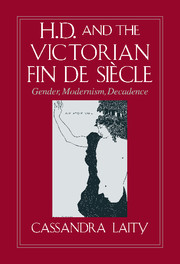Book contents
- Frontmatter
- Contents
- Acknowledgments
- Introduction: Dramatis Personae: The Aesthete Androgyne and the Femme Fatale
- 1 The Rhetoric of Anti-Romanticism: Gendered Genealogies of Male Modernism
- 2 H.D.'s Early Decadent Masks and Images: HER; Sea Garden
- The Aesthete Androgyne
- The Femme Fatale
- Postscript
- Notes
- Index
- CAMBRIDGE STUDIES IN AMERICAN LITERATURE AND CULTURE
Postscript
Published online by Cambridge University Press: 06 January 2010
- Frontmatter
- Contents
- Acknowledgments
- Introduction: Dramatis Personae: The Aesthete Androgyne and the Femme Fatale
- 1 The Rhetoric of Anti-Romanticism: Gendered Genealogies of Male Modernism
- 2 H.D.'s Early Decadent Masks and Images: HER; Sea Garden
- The Aesthete Androgyne
- The Femme Fatale
- Postscript
- Notes
- Index
- CAMBRIDGE STUDIES IN AMERICAN LITERATURE AND CULTURE
Summary
Although it is beyond the scope of this book to map the continuities between anti-Romantic modernism and certain masculinist postmodernisms, at least one feminist critic, Alicia Ostriker, has blamed Eliot's “‘extinction of personality’” and the currently “popular critical fiction” of “the death of the author” for the oppression of the feminine “I” in Anglo/ American literary modernity. I suggest further that the implicitly or explicitly gender-biased flight from romantic “selfhood” urged by modern, New Critical, and postmodern critics from Yeats and Eliot to Frank Kermode, Harold Bloom, and Roland Barthes may be traced back, in part, to the crisis in sexual definition provoked by the transgressive “personalities” – female and “effeminate” male – of the last century.
It is therefore, perhaps, no accident that H.D. (and I) dramatize two types of the abject male and female body that are resurfacing again in the personae of the lesbian vampire, femme fatale, Greek male youth, and others in gender (gay/lesbian/feminist) studies.
- Type
- Chapter
- Information
- H. D. and the Victorian Fin de SiècleGender, Modernism, Decadence, pp. 185 - 186Publisher: Cambridge University PressPrint publication year: 1996

